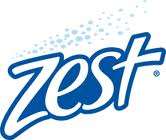Zest (brand)
 | |
| Product type | Soap, body wash |
|---|---|
| Owner | Brynwood Partners, via High Ridge Brands, Inc. |
| Country | U.S. |
| Introduced | 1955 |
| Markets | U.S. |
| Previous owners | Procter & Gamble, Unilever |
| Tagline | "Zestfully clean!" |
| Website |
www |
Zest is a brand name, or trademark, which Procter & Gamble introduced in 1955[1] with the slogan "For the first time in your life, feel really clean." Early commercials stated that Zest is not a soap, because it does not leave the sticky film that soap does. A 1970-era commercial illustrated this concept with an apparent demonstration in which two photographs of a person were each dipped in one of two bowls, one labeled "soap" and the other "Zest" — the one that came out of the "soap" bowl had a scummy coating whereas the one that came out of the "Zest" bowl had no such coating.
The brand experienced an uptick in sales in the 1980s and early 1990s, with the advertising slogan "you're not fully clean unless you're Zestfully clean!", coined by the BBDO sloganeer James Jordan. One commercial showed a teenage girl who used ordinary soap scratching her back against the metal pole of a school bus stop sign at her bus stop because her soap left a sticky film that she couldn't see but she could sure feel. While still scratching her back, the bus shows up. Yet another commercial featured NFL fullback Craig "Ironhead" Heyward promoting the Zest bodywash product: a liquid in a plastic bottle. Television commercials would incorporate the slogan as part of the jingle and end with someone displaying a towel with the "Zestfully clean" slogan on the back; these towels have often been given away in company promotions.
The trademark was originally used (1958 to 2006) to market a "deodorant bar" that included both standard soap and synthetic detergent ingredients. The synthetic detergent prevented the deposition of soap scum in the presence of hard water. Marbled in appearance, it originally came in two forms: the Aqua and the yellow lemon-scented Citrus. By the mid-1960s, the bar no longer had a marbled appearance.
P&G announced that it is selling Zest to Unilever in December 2014. The companies expect to complete the deal during the first half of 2015.[2]
Brand dilution
In 2007, in a seeming about-face of their 'no soap film' policy, Procter & Gamble discontinued the old product and reassigned the trademark to a soap bar with a size reduced by 11% (from 4.5 to 4.0 ounces), a new bar shape, and new, more intense fragrance. The brand was further diluted by the introduction of bottled liquid Zest. A recent perusal of their support site yielded the following claim: "Zest Linen Fresh, Tropical Fresh and Tangerine Mango Twist are no longer made with synthetic ingredients. They’re 100% soap and have a new “surf” shape."
At one time, the range of products marketed as Zest comprised Aqua Pure, Energy Fresh, Linen Fresh, Ultimate Clean (said to offer antibacterial action), Spring Burst, Tropical Fresh, and Whitewater Fresh; along with three liquid body washes, Spring Splash, Morning Garden, and Ocean Energy.
The Zest site now features several variants: Aqua Pure, Aloe Splash, Ocean Energy (featuring Energizing Effects), Mint Explosion (featuring Stimulating Effects), Tangerine Mango Twist (featuring Stimulating Effects), and Whitewater Fresh (which was originally discontinued in 2006, but was brought back in 2012). Each variant was advertised as being available as both a bar and a bottled liquid labeled as "Bodywash." According to the ingredient list on a recently purchased bottle of Zest Ocean Energy Bodywash, the product is a synthetic detergent solution with other additives.
On January 4, 2011, it was announced that Procter and Gamble had sold the brand to High Ridge Brands Co.
As of November 1, 2012, Zest is still being distributed by Procter and Gamble in the Philippines.
References
- ↑ Davis, Dyer; et al. (May 1, 2004). Rising Tide: Lessons from 165 Years of Brand Building at Procter and Gamble. Harvard Business Press. p. 426. Retrieved 2013-05-07.
- ↑ "P&G shedding Camay, Zest brands". 22 December 2014. Retrieved 6 January 2015.